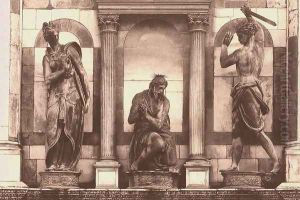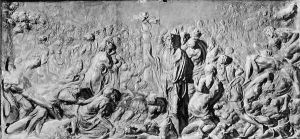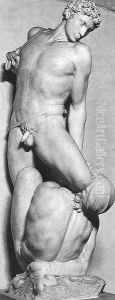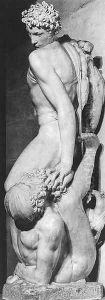Vincenzo Danti Paintings
Vincenzo Danti was an Italian Renaissance sculptor, architect, and writer born in Perugia, Italy, in 1530. He was part of a family of artists; his father was Giulio Danti, a painter and architect, and his brother Ignazio became a prominent mathematician and astronomer. Vincenzo initially trained with his father before moving to Rome around 1545, where he was influenced by the work of Michelangelo, who was completing the Last Judgment in the Sistine Chapel at that time.
In Rome, Danti continued his artistic education and soon caught the attention of influential patrons. He was particularly adept at bronze sculpting, a medium through which he produced some of his most notable works. One of his early successes was the 'Beheading of St. John the Baptist' for the baptismal font in the Baptistery of San Giovanni in Florence, which showcased his ability to portray dramatic narratives with emotional intensity.
Danti's reputation grew, and in 1563, he became a member of the prestigious Accademia delle Arti del Disegno in Florence, founded by Cosimo I de' Medici and Giorgio Vasari. His involvement with the Accademia and the Medici court tied him to the intellectual and artistic heart of the Italian Renaissance. He worked on several projects for the Medici, including the design and realization of ornamental sculptures for the Palazzo Vecchio.
Aside from his sculptural work, Danti was also involved in architectural projects. He served as the architect for the fortifications of Perugia and other Tuscan cities. As a writer, he contributed to the discourse on art with his treatise 'Trattato delle perfette proporzioni', which explored the theories of perfect proportions in art, an idea that was central to Renaissance aesthetics.
Danti's later works continued to reflect his deep engagement with the classical tradition and the influence of Michelangelo. However, his style also evolved to include elements of Mannerism, characterized by elongated figures and exaggerated poses that were popular in the late Renaissance.
Vincenzo Danti's life was cut short when he died in 1576 at the age of 46. Despite his relatively brief career, his contributions to Renaissance art, particularly in sculpture, left a lasting impact on the art world. His works can still be appreciated in various locations in Italy, and his writings continue to be of interest to art historians studying Renaissance theories of proportion and aesthetics.



